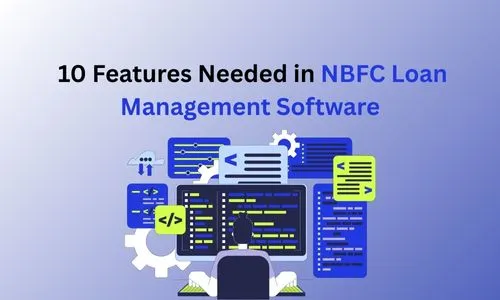Top 10 Features That Are Needed in NBFC Loan Management Software

What is Agent Factory: Top 5 Agent Observability Best Practices
August 28, 2025
What is NBFC loan management Software?| Importance and Benefits
September 5, 2025The financial sector is evolving rapidly, with non-banking financial companies (NBFCs) at the forefront of providing accessible lending solutions. To stay competitive, these organizations rely on robust NBFC Loan Management Software that streamlines operations, enhances efficiency, and ensures regulatory adherence. This technology serves as the backbone for handling loans from origination to repayment, minimizing errors and boosting productivity. In this article, we explore the must-have features that make such software indispensable for modern NBFCs.
Understanding the Role of Advanced Loan Management Tools
Before diving into specifics, it’s crucial to recognize how specialized software transforms NBFC operations. These platforms go beyond basic tracking, offering integrated solutions that adapt to diverse lending needs. By incorporating cutting-edge functionalities, NBFCs can reduce manual interventions, improve decision-making, and foster customer satisfaction. The features discussed here are designed to address common challenges like data silos, compliance hurdles, and scalability issues.
1. Comprehensive Collateral and Facility Oversight
Effective management of collaterals and facilities forms the core of secure lending practices. This feature allows NBFCs to track assets pledged against loans in real-time, ensuring accurate valuation and quick retrieval during defaults. It includes automated alerts for collateral depreciation or renewal deadlines, reducing risks associated with asset mismanagement. Additionally, facility management streamlines the allocation of credit lines, enabling seamless adjustments based on borrower profiles. By integrating this into the software, NBFCs can enhance loan security, prevent fraud, and maintain a healthy portfolio balance. Users benefit from intuitive interfaces that display collateral details alongside loan statuses, promoting transparency and operational speed.
2. Customized Dashboards Based on User Roles
Personalized dashboards tailored to specific roles revolutionize how teams interact with the system. For instance, executives might see high-level analytics, while loan officers access detailed application pipelines. This segmentation ensures that each user views relevant data without overwhelming information overload. Features like drag-and-drop widgets allow customization, incorporating KPIs such as approval rates or delinquency trends. Such dashboards foster collaboration across departments, from underwriting to collections, by providing role-specific insights. Ultimately, this leads to faster decision-making and reduced training time for new staff, making the software more user-friendly and efficient in daily workflows.
3. Mobile-Friendly Loan Origination Capabilities
In today’s mobile-driven world, origination modules that support on-the-go access are essential. This functionality enables field agents to initiate loan applications directly from smartphones or tablets, capturing applicant details via integrated forms and e-signatures. It supports offline modes for remote areas, syncing data once connectivity resumes. Benefits include quicker turnaround times for approvals and reduced paperwork, appealing to tech-savvy borrowers. NBFCs can leverage GPS integration for location-based verifications, adding a layer of authenticity to the process. Overall, this feature expands reach, especially in underserved markets, while maintaining data integrity through secure encryption protocols.
4. Intelligent Document Linking and Organization
Streamlining document handling through smart mapping is a game-changer for compliance and efficiency. This tool automatically associates uploaded files—like IDs, financial statements, or agreements—with corresponding loan records, using AI-driven categorization. It eliminates manual filing errors and enables quick searches via metadata tags. Version control tracks changes, ensuring audit trails for regulatory reviews. For NBFCs, this means faster processing cycles and lower administrative costs. Advanced search filters allow retrieval based on keywords or dates, supporting seamless collaboration among teams. By digitizing and organizing documents effectively, the software minimizes risks of lost information and enhances overall operational reliability.
5. User-Friendly Graphical Interface for Configurations
A graphical user interface (GUI) for system setups empowers non-technical users to customize workflows without coding expertise. Drag-and-drop elements simplify defining loan parameters, approval hierarchies, or interest calculations. This flexibility allows NBFCs to adapt quickly to market changes, such as new interest rate policies. Built-in validation checks prevent configuration errors, ensuring system stability. Training becomes minimal as the intuitive design mimics familiar applications. In essence, this feature democratizes software management, enabling business users to innovate processes independently, which accelerates time-to-market for updates and reduces dependency on IT support.
6. Accelerated Development of New Lending Products
Speedy creation of innovative loan products is vital for staying ahead in competitive landscapes. This capability lets NBFCs design custom offerings, like microloans or green financing, through modular templates. Users can define terms, eligibility criteria, and pricing models with minimal effort, often in hours rather than weeks. Integration with analytics tools predicts product performance based on historical data. For dynamic markets, this ensures agility, allowing quick responses to economic shifts. The result is diversified portfolios that attract varied customer segments, boosting revenue streams while maintaining compliance through embedded checks.
7. Integrated Compliance Monitoring and Risk Evaluation
Navigating regulatory landscapes requires built-in tools for compliance and risk analysis. This feature automates checks against laws like KYC and AML, flagging potential issues early. Risk scoring models assess borrower creditworthiness using multifaceted data, including behavioral patterns. Real-time dashboards highlight portfolio risks, enabling proactive mitigation strategies. NBFCs benefit from reduced penalties and enhanced trust from stakeholders. Customizable rules adapt to regional regulations, ensuring global scalability. By embedding these elements, the software not only safeguards operations but also supports ethical lending practices that align with industry standards.
8. Dynamic Rule Setting and Enforcement
Flexible rule management allows NBFCs to define and update business logic effortlessly. This includes setting thresholds for loan approvals, interest accruals, or penalty applications via a no-code environment. Rules can be conditional, adapting to scenarios like economic downturns. Automation ensures consistent application across all loans, minimizing human bias. Analytics track rule effectiveness, suggesting optimizations over time. For growing operations, this scalability prevents bottlenecks, supporting volume increases without proportional staff growth. Ultimately, it empowers strategic decision-making, aligning software behavior with organizational goals for sustained efficiency.
9. Instantaneous Data Collection and Processing
Capturing data in real-time is crucial for accurate, up-to-date insights. This functionality integrates with various sources, like APIs from credit bureaus or internal databases, to pull information instantly during loan cycles. It supports live updates on borrower status, such as employment changes, affecting risk profiles dynamically. Benefits include faster approvals and personalized offers based on current data. Security measures like encryption protect sensitive inputs, complying with data privacy laws. For NBFCs, this means agile operations that respond to market volatilities, improving customer experiences through timely, informed interactions.
10. Seamless Cloud Deployment Options
Cloud-ready deployment ensures accessibility and scalability without heavy infrastructure investments. This feature supports hybrid or full-cloud models, with auto-scaling for peak demands. Data backups and disaster recovery are automated, enhancing reliability. NBFCs can access the system globally, facilitating remote work and branch expansions. Cost savings arise from pay-as-you-go models, avoiding upfront hardware expenses. Integration with cloud services like analytics or AI adds value, future-proofing the software. In summary, this deployment ease accelerates adoption, allowing focus on core business rather than IT maintenance.
Why These Features Matter for NBFC Success
Incorporating these elements into loan management systems isn’t just about technology—it’s about building resilient, customer-centric operations. NBFCs that prioritize such features experience lower default rates, higher satisfaction scores, and improved profitability. As the lending industry digitizes further, investing in comprehensive software becomes a strategic imperative.
Final Thoughts on Optimizing Loan Management
Selecting software with these top features positions NBFCs for long-term growth. Regular updates and user feedback loops can refine these tools, ensuring they evolve with business needs. By focusing on efficiency, security, and innovation, organizations can thrive in a competitive environment, delivering value to both borrowers and stakeholders.


